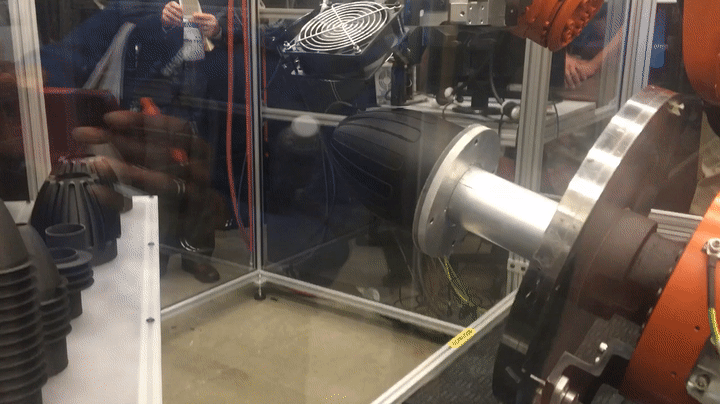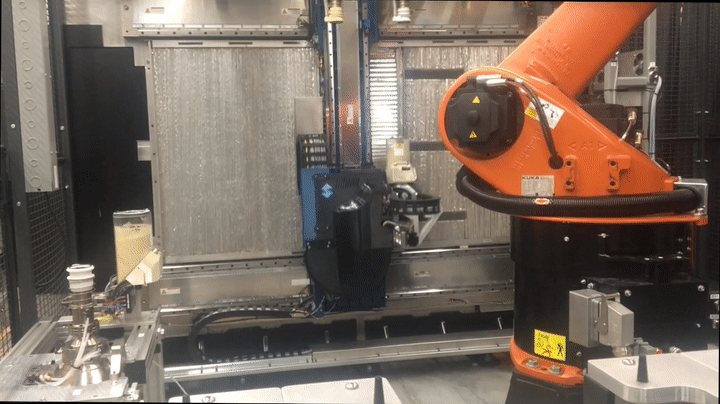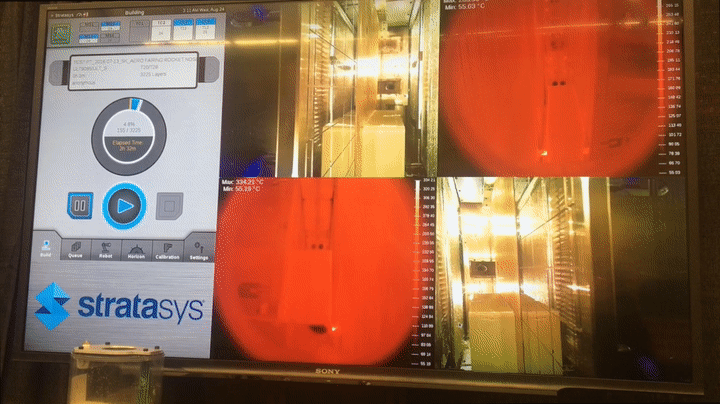The Next Evolution In The 3D Printing Revolution
August 26, 2016
Infinite-Build Flags
The flag, made of red, white and blue Ultem 9085 micro-pellets, took 30 hours to build and the tool changer swapped the tools 70 times. The robotic arm is integrated for automated operation unattended.

The Robotic Composite 3D Demonstrator
3D printing has already revolutionized the manufacturing industry by turning supply chains and production speed on its head. These two new advancements in additive manufacturing will likely spur increased adoption of the technology in the aviation and automotive industry, with the likes of Boeing and Ford Motor Co., which provided input on potential machine applications.
The Robotic Composite 3D Demonstrator and the Infinite-Build 3D Demonstrator were announced at the Stratasys media event Aug 23. These two printers provide capabilities not yet seen in additive manufacturing--increased production speed, limitless length of the end product and rotating design growth versus a traditional lateral build with composites.
This is the Robotic Composite 3D Demonstrator, which offers automated production of high-value, lightweight composite production parts.
The video shows Stratsys' Robotic Composite 3D Demonstrator in action, consisting of an 8-axes motion system, tilting during the rib-adding process of creating this black dome (explained in slide 5). The complete dome production takes 90 min. and the rib-adding process takes 30 min.
This article was updated at 1:42 PM CST, August 31

Applications Not Yet Defined
The printers will be showcased at the International Manufacturing Technology Show Sept. 12-17 in Chicago with hopes of gaining more feedback from potential customers or for use-cases: “Traditionally we’ve been known as a company that has made great printers, but we’re now very focused on the application and use case," says Rich Garrity, president of Americas for Stratasys.
Kerry Stevenson, founder and editor of 3D Printing online publication Fabbaloo, says Stratasys could be setting a new manufacturing precedent in the industry: "It’s now very clear they are seeking to adapt (and even invent) their technology to address specific needs of industry, who have up to now only been able to use 3D printing equipment in limited ways. If these concepts catch on with industries like aerospace, I can see Stratasys, and indeed other 3D printer manufacturers, developing even more specialty 3D making equipment to overcome industry manufacturing challenges."

Parts Outlook
"While the adoption and appetite for composite parts is growing dramatically, the way to make those parts is still done very much the same way it has been done for many years,” says Garrity. The market for aerospace composite structures this year alone is $13 billion.

Siemens Software
The software for the Robotic Composite 3D Demonstrator is powered by NX Siemens, and the motion controls and PLM software integrate with Stratasys’ additive manufacturing technologies.
“By working closely with Stratasys on motion control and CNC automation, Siemens is helping to create a flexible, multi-function manufacturing workflow that puts 3D printing firmly in the factory,” says Arun Jain, VP, Motion Control, Digital Factory US, Siemens.

Dome For Example
The dome, which serves no existing machine functional purpose, was created for the Robotics Composite Demonstrator to show the 8-axes print from the inside-out, rather than layer-by-layer printing. The part was produced without any support by continuous reinforcement.

Additional Example Parts
The central domes are produced with a single spiral toolpath that eliminates any seams or layer transitions. The reinforcing rips are printed orthogonal to the dome layers, also in a single toolpath that follows a complex curve through space.
Currently, the printer can fill thermoplastic material with chopped or long carbon fibers. Stratasys hopes to offer continuous carbon fiber reinforcement in the future.

The Infinite-Build 3D Demonstrator
The second new machine, the Infinite-Build 3D Demonstrator, maximizes size capability offerings for parts through unconstrained length build, speed of production at 10 times faster than current printers like the Stratasys 9000mc, tool change functionality, unattended operation and added quality through processes control and reliable repeatability.
This means that a part could be endless feet long and manufactured in days without any manual tool changes or constant supervision.

Large Parts Might Know No Limits
Application use of the fused deposition modeling (FDM) Infinite-Build for aerospace includes interior parts for aircraft, a $13.5 billion market in 2015. Large panels or ducts that are multiple feet long could be created in one piece with significant weight reduction benefits and lower variability risk, according to Stratasys.
Stratasys showcased the Infinite Build 3D additive printer and explained partnerships with Boeing, Ford and Siemens. The partners were the only customers aware of the project and helped dictate requirements of the machine and possible end-use cases.

Refilling The Material
There are up to four refill containers at 30 lbs. each mounted to the demonstrator, with additional containers available within the machine space to be interchanged by the robotic arm. Hypothetically, the system could run weeks at a time without stopping.

Aircraft Window Panel Fully By Infinite-Build
This aircraft windows prototype took 80 hours in 1000 layers. The part, taken from a scan of an old aircraft, was provided by Boeing to see if it was viable to complete. Created out of Ultem 9085 micro-pellets, the part could meet flammability, smoke and toxicity requirements for certified aircraft interiors.
“They’ve been pushing us for over a decade to be better for their own manufacturing needs. They’ve been a great partner in that,” says Jim Orrock, vice president, product leader for Stratasys.
“This Infinite Build allows us to build much larger tools that we could use in both assembly and fabrication, mostly fabrication, to help in our lower-rate production-type applications,” says Teri Finchamp, director of operations of quality for Boeing Phantom Works.
For now, Finchamp says Boeing is focused on non-flight critical and defense applications of the Infinite Build technology. ESC (environmental control system) parts and spare parts would be the potential next uses for Boeing.

The Spiral
This sample spiral part model was displayed at the Stratasys facility, measuring 16 ft. in length, took six continuous days to complete. It’s the longest printed part completed by the Infinite-Build 3D Demonstrator to date.
Stratasys is in discussions with a current partner to potentially print a 20 ft. long wing for a high-payload UAV (unmanned aeriel vehicle).

Infinite-Build Flags
The flag, made of red, white and blue Ultem 9085 micro-pellets, took 30 hours to build and the tool changer swapped the tools 70 times. The robotic arm is integrated for automated operation unattended.

The Robotic Composite 3D Demonstrator
3D printing has already revolutionized the manufacturing industry by turning supply chains and production speed on its head. These two new advancements in additive manufacturing will likely spur increased adoption of the technology in the aviation and automotive industry, with the likes of Boeing and Ford Motor Co., which provided input on potential machine applications.
The Robotic Composite 3D Demonstrator and the Infinite-Build 3D Demonstrator were announced at the Stratasys media event Aug 23. These two printers provide capabilities not yet seen in additive manufacturing--increased production speed, limitless length of the end product and rotating design growth versus a traditional lateral build with composites.
This is the Robotic Composite 3D Demonstrator, which offers automated production of high-value, lightweight composite production parts.
The video shows Stratsys' Robotic Composite 3D Demonstrator in action, consisting of an 8-axes motion system, tilting during the rib-adding process of creating this black dome (explained in slide 5). The complete dome production takes 90 min. and the rib-adding process takes 30 min.
This article was updated at 1:42 PM CST, August 31

Applications Not Yet Defined
The printers will be showcased at the International Manufacturing Technology Show Sept. 12-17 in Chicago with hopes of gaining more feedback from potential customers or for use-cases: “Traditionally we’ve been known as a company that has made great printers, but we’re now very focused on the application and use case," says Rich Garrity, president of Americas for Stratasys.
Kerry Stevenson, founder and editor of 3D Printing online publication Fabbaloo, says Stratasys could be setting a new manufacturing precedent in the industry: "It’s now very clear they are seeking to adapt (and even invent) their technology to address specific needs of industry, who have up to now only been able to use 3D printing equipment in limited ways. If these concepts catch on with industries like aerospace, I can see Stratasys, and indeed other 3D printer manufacturers, developing even more specialty 3D making equipment to overcome industry manufacturing challenges."

Parts Outlook
"While the adoption and appetite for composite parts is growing dramatically, the way to make those parts is still done very much the same way it has been done for many years,” says Garrity. The market for aerospace composite structures this year alone is $13 billion.

Siemens Software
The software for the Robotic Composite 3D Demonstrator is powered by NX Siemens, and the motion controls and PLM software integrate with Stratasys’ additive manufacturing technologies.
“By working closely with Stratasys on motion control and CNC automation, Siemens is helping to create a flexible, multi-function manufacturing workflow that puts 3D printing firmly in the factory,” says Arun Jain, VP, Motion Control, Digital Factory US, Siemens.

Dome For Example
The dome, which serves no existing machine functional purpose, was created for the Robotics Composite Demonstrator to show the 8-axes print from the inside-out, rather than layer-by-layer printing. The part was produced without any support by continuous reinforcement.

Additional Example Parts
The central domes are produced with a single spiral toolpath that eliminates any seams or layer transitions. The reinforcing rips are printed orthogonal to the dome layers, also in a single toolpath that follows a complex curve through space.
Currently, the printer can fill thermoplastic material with chopped or long carbon fibers. Stratasys hopes to offer continuous carbon fiber reinforcement in the future.

The Infinite-Build 3D Demonstrator
The second new machine, the Infinite-Build 3D Demonstrator, maximizes size capability offerings for parts through unconstrained length build, speed of production at 10 times faster than current printers like the Stratasys 9000mc, tool change functionality, unattended operation and added quality through processes control and reliable repeatability.
This means that a part could be endless feet long and manufactured in days without any manual tool changes or constant supervision.

Large Parts Might Know No Limits
Application use of the fused deposition modeling (FDM) Infinite-Build for aerospace includes interior parts for aircraft, a $13.5 billion market in 2015. Large panels or ducts that are multiple feet long could be created in one piece with significant weight reduction benefits and lower variability risk, according to Stratasys.
Stratasys showcased the Infinite Build 3D additive printer and explained partnerships with Boeing, Ford and Siemens. The partners were the only customers aware of the project and helped dictate requirements of the machine and possible end-use cases.

Refilling The Material
There are up to four refill containers at 30 lbs. each mounted to the demonstrator, with additional containers available within the machine space to be interchanged by the robotic arm. Hypothetically, the system could run weeks at a time without stopping.

Aircraft Window Panel Fully By Infinite-Build
This aircraft windows prototype took 80 hours in 1000 layers. The part, taken from a scan of an old aircraft, was provided by Boeing to see if it was viable to complete. Created out of Ultem 9085 micro-pellets, the part could meet flammability, smoke and toxicity requirements for certified aircraft interiors.
“They’ve been pushing us for over a decade to be better for their own manufacturing needs. They’ve been a great partner in that,” says Jim Orrock, vice president, product leader for Stratasys.
“This Infinite Build allows us to build much larger tools that we could use in both assembly and fabrication, mostly fabrication, to help in our lower-rate production-type applications,” says Teri Finchamp, director of operations of quality for Boeing Phantom Works.
For now, Finchamp says Boeing is focused on non-flight critical and defense applications of the Infinite Build technology. ESC (environmental control system) parts and spare parts would be the potential next uses for Boeing.

The Spiral
This sample spiral part model was displayed at the Stratasys facility, measuring 16 ft. in length, took six continuous days to complete. It’s the longest printed part completed by the Infinite-Build 3D Demonstrator to date.
Stratasys is in discussions with a current partner to potentially print a 20 ft. long wing for a high-payload UAV (unmanned aeriel vehicle).

Infinite-Build Flags
The flag, made of red, white and blue Ultem 9085 micro-pellets, took 30 hours to build and the tool changer swapped the tools 70 times. The robotic arm is integrated for automated operation unattended.


















